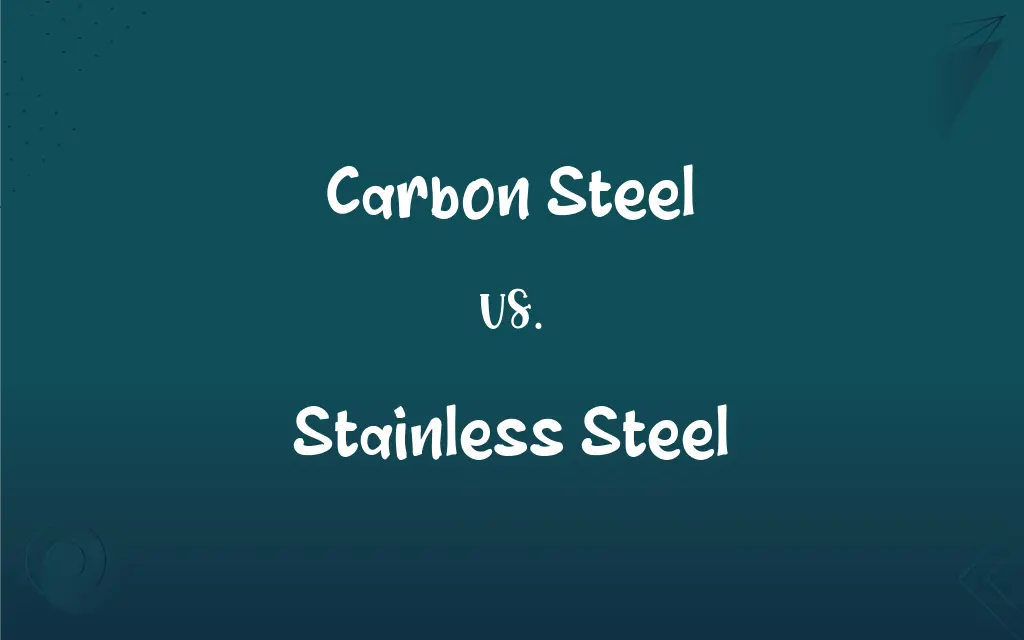Carbon Steel vs. Stainless Steel: What's the Difference?
Edited by Janet White || By Harlon Moss || Updated on October 18, 2023
Carbon steel contains primarily iron and carbon, while stainless steel includes iron, carbon, and at least 10.5% chromium for corrosion resistance.

Key Differences
Carbon steel and stainless steel, both essential materials in various industries, differ in composition, properties, and applications. Carbon steel, as its name suggests, consists mainly of iron and a significant amount of carbon. Depending on the carbon content, which can range from less than 0.03% to over 2%, carbon steel can exhibit varying hardness, strength, and ductility. It's favored for its ability to be forged into sharp blades and its high tensile strength.
Stainless steel, on the other hand, is a steel alloy containing a minimum of 10.5% chromium. This chromium content is vital because it forms a protective oxide layer on the surface of the metal, making it resistant to corrosion and staining. Stainless steel might also contain elements like nickel, molybdenum, or nitrogen, further enhancing its properties and making it particularly suitable for environments where corrosion is a concern.
Despite its strength and durability, carbon steel is more prone to rust when exposed to moisture and air. This rusting can be mitigated by coatings or treatments, but over prolonged exposure, without protection, carbon steel will corrode. Its natural vulnerability to corrosion makes it less suitable for applications where it might come into regular contact with corrosive substances or moisture.
Stainless steel, with its inherent resistance to rust and staining, is often chosen for applications demanding a clean, bright finish or where hygiene is a priority, like in kitchen utensils, medical instruments, or certain architectural elements. However, it's worth noting that while stainless steel is resistant to rust, it isn't entirely rust-proof, and under certain conditions or with specific stainless steel grades, it can corrode.
Comparison Chart
Primary Composition
Iron + Carbon
Iron + Carbon + Chromium (min 10.5%)
ADVERTISEMENT
Corrosion Resistance
Lower resistance, prone to rust
High resistance due to chromium content
Applications
Blades, structures, rails
Kitchen utensils, medical tools, architecture
Price
Generally less expensive
More expensive due to added elements
Hardening
Can be heat-treated for increased hardness
Certain grades can be heat-treated for hardness
Carbon Steel and Stainless Steel Definitions
Carbon Steel
An alloy of iron and carbon without significant amounts of other alloying elements.
Carbon steel blades are often used in chef's knives.
ADVERTISEMENT
Stainless Steel
An alloy of iron, carbon, and a minimum of 10.5% chromium.
Stainless steel cutlery remains shiny even after multiple uses.
Carbon Steel
A metal known for its malleability and strength.
Carbon steel plates are common in construction projects.
Stainless Steel
Steel that contains additional elements like nickel or molybdenum for enhanced properties.
Stainless steel watches are resistant to sweat and moisture.
Carbon Steel
A metal with a high carbon content for increased hardness.
Carbon steel pipes are integral in industrial applications.
Stainless Steel
Steel known for its resistance to corrosion and staining.
Stainless steel sinks are popular for their sleek appearance and durability.
Carbon Steel
Steel susceptible to oxidation without protective coatings.
Unprotected carbon steel structures need regular maintenance to prevent rust.
Stainless Steel
A versatile steel with aesthetic appeal.
Many modern buildings feature stainless steel facades.
Carbon Steel
A type of steel that can be heat-treated for improved durability.
Carbon steel tools are popular for their long-lasting edge.
Stainless Steel
Metal alloy used where hygiene is a priority.
Medical instruments are often made of stainless steel for sterilization purposes.
FAQs
Which is more expensive, carbon steel or stainless steel?
Typically, stainless steel due to its alloying elements.
Can carbon steel rust easily?
Yes, especially without protective coatings or treatments.
What primarily distinguishes carbon steel from stainless steel?
The key difference is chromium content, which gives stainless steel its corrosion resistance.
Are there different grades of carbon steel?
Yes, based on carbon content: low, medium, and high carbon steel.
Which is better for knife blades, carbon steel or stainless steel?
Carbon steel can hold a sharper edge, but stainless steel is more rust-resistant.
Is carbon steel magnetic?
Yes, it typically is.
Can carbon steel be welded easily?
Generally, yes, but precautions must be taken to avoid brittleness.
Is carbon steel more durable than stainless steel?
Carbon steel can be harder and stronger, but stainless steel has better corrosion resistance.
Can stainless steel be magnetic?
Some grades are, but many, like those with high nickel content, are not.
Why is stainless steel popular in kitchens?
Due to its corrosion resistance and hygienic properties.
What gives stainless steel its shiny appearance?
Its chromium content forms a protective, reflective oxide layer.
Where is carbon steel commonly used?
In structural applications, tools, and some cookware.
Is stainless steel completely rust-proof?
No, but it is highly resistant to rust.
Is stainless steel safe for cooking?
Yes, it's a popular and safe material for cookware.
Why is carbon added to steel?
It increases hardness and strength when appropriately alloyed.
Is carbon steel good for frying pans?
Yes, it offers excellent heat distribution but requires seasoning to prevent rust.
What makes stainless steel "stainless"?
The presence of chromium, which forms a protective oxide layer, preventing staining and corrosion.
How can you protect carbon steel from rust?
By applying protective coatings, paints, or oils.
Are all stainless steels equally corrosion-resistant?
No, corrosion resistance can vary based on the alloy's specific composition.
How can you differentiate between carbon steel and stainless steel by appearance?
Stainless steel usually has a shinier and smoother surface, but testing is more reliable.
About Author
Written by
Harlon MossHarlon is a seasoned quality moderator and accomplished content writer for Difference Wiki. An alumnus of the prestigious University of California, he earned his degree in Computer Science. Leveraging his academic background, Harlon brings a meticulous and informed perspective to his work, ensuring content accuracy and excellence.
Edited by
Janet WhiteJanet White has been an esteemed writer and blogger for Difference Wiki. Holding a Master's degree in Science and Medical Journalism from the prestigious Boston University, she has consistently demonstrated her expertise and passion for her field. When she's not immersed in her work, Janet relishes her time exercising, delving into a good book, and cherishing moments with friends and family.






































































